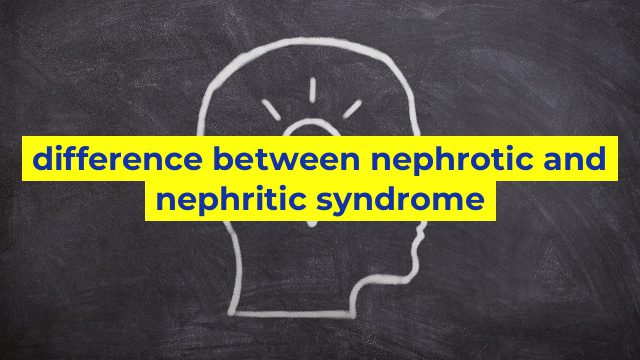The Difference Between Nephrotic and Nephritic Syndrome
Nephrotic and nephritic syndrome are two conditions that affect the kidneys. While they both have similar symptoms, they have different underlying causes and treatment approaches.
Nephrotic Syndrome
Nephrotic syndrome is a kidney disorder that results in the loss of protein through the urine. This condition occurs when the filtering units of the kidneys, called glomeruli, become damaged. As a result, large amounts of protein are leaked into the urine, causing a decrease in the amount of protein in the blood.
Common symptoms of nephrotic syndrome include:
– Swelling in the legs, feet, and ankles
– Weight gain due to fluid retention
– Foamy urine
– Fatigue
– Loss of appetite
– High blood pressure
The most common cause of nephrotic syndrome is a disease called minimal change disease, but other conditions such as diabetes, lupus, and infections can also be a cause.
Treatment for nephrotic syndrome involves managing symptoms and controlling the underlying cause. Medications such as diuretics and ACE inhibitors may be prescribed to help reduce swelling and control blood pressure. Corticosteroids may also be prescribed to reduce inflammation and decrease proteinuria.
Nephritic Syndrome
Nephritic syndrome is a kidney disorder characterized by inflammation that damages the glomeruli. This condition often results in blood and protein being excreted in the urine. Unlike nephrotic syndrome, nephritic syndrome can also cause hypertension and impaired kidney function.
Symptoms of nephritic syndrome include:
– Blood in urine
– Protein in urine
– High blood pressure
– Swelling in the face, hands, and feet
– Decreased urine output
The most common cause of nephritic syndrome is an autoimmune disease called IgA nephropathy, but other conditions such as lupus, infections, and genetic disorders can contribute to its development.
Treatment for nephritic syndrome focuses on controlling symptoms and underlying causes. Medications such as corticosteroids, blood pressure medications, and immunosuppressants may be prescribed to control inflammation and improve kidney function.
The Bottom Line
While nephrotic and nephritic syndrome share similar symptoms, they have different underlying causes and require different treatment approaches. If you experience any of the symptoms associated with these conditions, it is important to seek medical attention promptly. By getting a proper diagnosis and treatment, you can manage the symptoms and improve your kidney health.
Table difference between nephrotic and nephritic syndrome
| Nephrotic Syndrome | Nephritic Syndrome | |
|---|---|---|
| Definition | A group of symptoms that occur due to damage to the kidneys leading to loss of protein in the urine | A group of symptoms that occur due to inflammation in the kidneys leading to damage to the glomeruli |
| Cause | Damage to the glomeruli of the kidneys | Inflammation of the glomeruli of the kidneys |
| Proteinuria | Increase in urinary protein excretion leading to hypoalbuminemia | Protein and blood in the urine |
| Edema | Severe edema and swelling of the body due to the loss of protein in the blood | Mild to moderate edema |
| Hypertension | Rare | Common |
| Urine color | Clear or yellowish | Dark and red or brownish due to blood in the urine |
| Treatment | Diuretics, sodium and fluid restriction, immunosuppressive therapy | Treatment of underlying cause, antihypertensive medication, antibiotics, immunosuppressive therapy |

